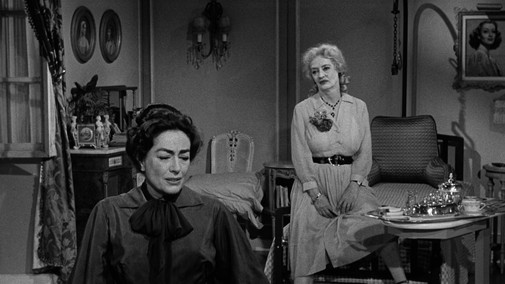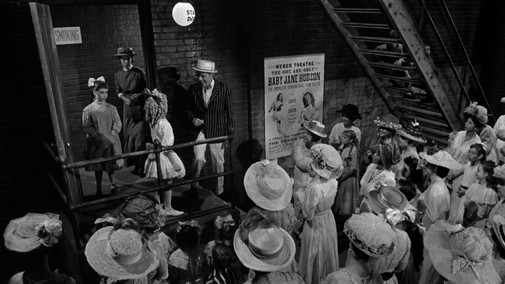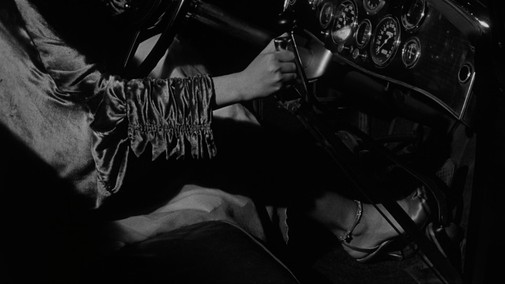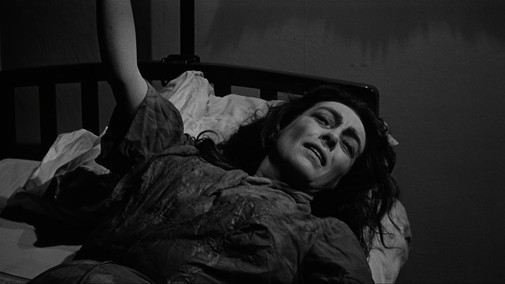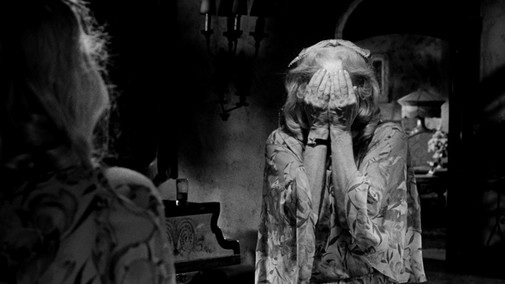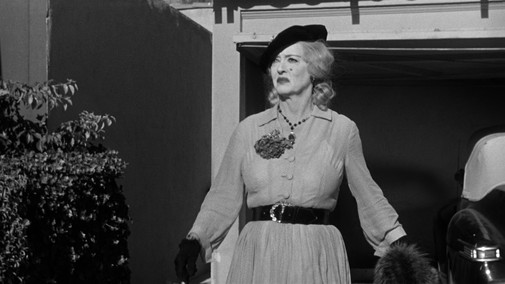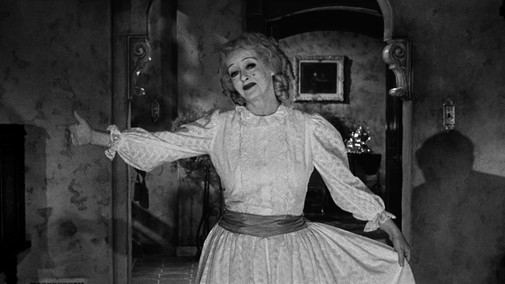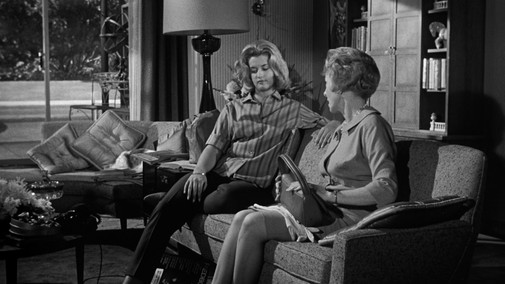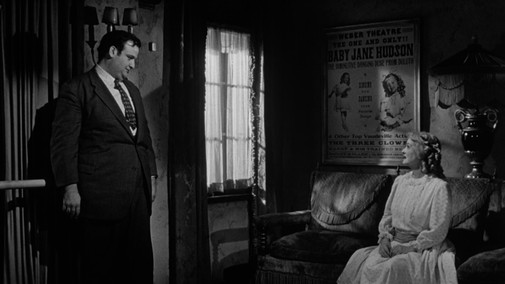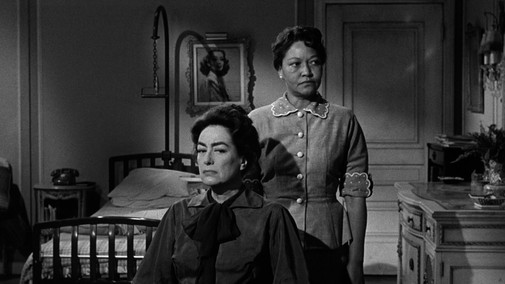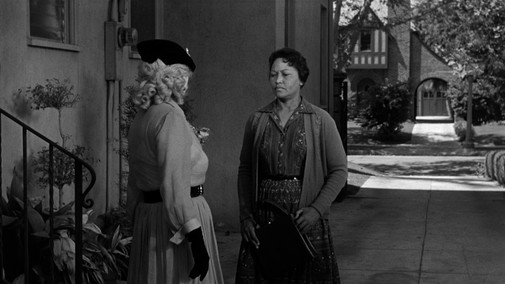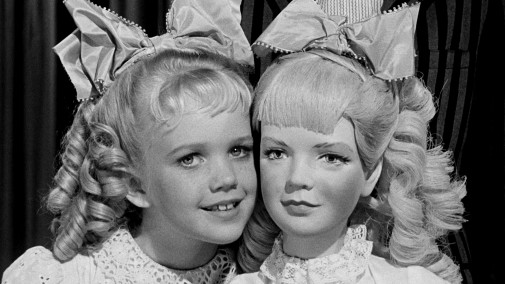
I had such grand plans for October. There was going to be plenty of spooky season with horror-themed write-ups and the return of my miniseries on scary movie costumes. But then COVID hit, and then the flu -- it's been a perpetual state of foggy-brained sickness. Still, it wouldn't do to let October end without one Horror Costuming post. even if I have to write the damned thing in between coughing fits. Since I already wrote about one one genre pic that won the Costume Oscar (the Eiko Ishioka-dressed Dracula) let's look at another. On its 60th anniversary, let's discuss the essential What Ever Happened to Baby Jane?, the genesis of the Grand Dame Guignol craze...
Despite what Ryan Murphy's misbegotten Feud will have you believe, the stars of Robert Aldrich's seminal 1962 horror didn't come up with their characters' looks on the fly mere moments before filming began. Though they might have contributed to their visual conception, there's a credited designer, too. Look it up, Norma Koch, who won the movie its only Academy Award. She'd go on to receive two additional nominations for Hush…Hush, Sweet Charlotte, and Lady Sings the Blues, and, by the time she dressed Bette Davis as Baby Jane, her filmography already featured such titles as the Best Picture-winning Marty and Joseph H. Lewis' brilliant Gun Crazy.
All this to say that Koch is an artist with a storied career who doesn't deserve to have her credited work erased by badly-recounted history. Not to mention that, sartorially speaking, there's much more to What Ever Happened to Baby Jane? than its starring rivals stars turned sisters from hell. After all, though primarily set in the present day of 1962, the story of the Hudson siblings starts long before. Aldrich opens the movie with a prolonged prologue, beginning in 1917 when Baby Jane is a vaudevillian sensation. The scene is a sea of early-20th-century lingerie dresses, lace inserts as far as the eye can, prim hats crowning heads of all ages with feathers, and fake flowers.
Some of these motifs will repeat, echoes of days gone by prevailing through times not their own. The past overstaying is one of the key visual themes of a film where the ravages of age make monsters of us all. It's not necessarily because growing old is grotesque, though, in these movies, it often is. Instead, one often finds the memories of youth curdled into ghost-like hauntings, poisoning the dusk of life with the reminder of what is gone, out of reach, lost. For the present to truly hurt, for decay to register, yesterday's image must remain palpable and vibrant, a sting of lemon over an open wound, salt rubbed on live flesh.
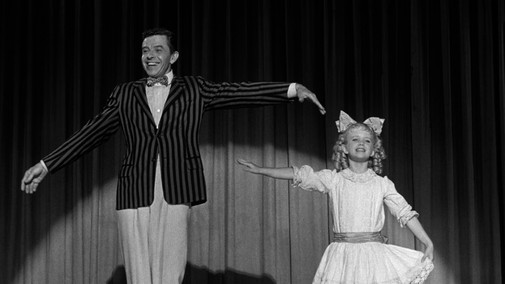
Of course, it's not the general fashion of the 1910s that invokes aching remembrance, but the specific look of success rotted away into obsolescence. Once upon a time, Baby Jane was a star in dropped waist child's clothes, satin bows on her back, and golden locks. Yet, before we see her image replicated in porcelain facsimiles - dolls her huckster father sells as merchandise - Jane already looks like something beyond real. The stench of artifice is overwhelming, projections of innocence as fake as those tattered silk florals peppered through the audience's millenary confections. As fake as daddy Hudson's oily grins.

In contrast to his angelic cherub of a daughter, his costume comprises complementing patterns, stripes on stripes that ring with a circus-like promise. Backstage, his wife looms in a sludge of grey, severe mid-tones in this monochrome frame. She matches Blanche, the daughter outside the limelight's glare, a sad bow on her hair like a cruel parody of her sister's stagey splendor. Jump to 1935, and the sisters have switched places. Blanche is a silver screen star, and the brat Jane only has a job because of the other woman's influence with the studios.
We don't see much of this time, flashes of studio lot glitz and little else. And yet, even here, Koch plants seeds from which the flower of truth might grow, the key to the plot's central mystery right there for the audience to find. So what do we see of the car accident that leaves Blanche in a wheelchair and Jane as her caretaker? Two women in soft dresses and metallic shoes. One drives the car, a dark shimmering sleeve draped over her arm. The other wraps a busy light-colored shawl around her shoulders. Is the fabric woven with a pattern, or is there lace or fur on the surface? It doesn't matter, only what these hints reveal about the identities at hand.
For all their transformations through aging, their evolving fortunes, the sisters' styles are a continuous line of steady repetition. Cut to the early 60s when the action begins in full, its protagonists are now monstrous archetypes of aged femininity as construed by Hollywood cliché. Blanche, who only wears two costumes henceforth, is a calcified cartoon of lady-like dignity, a twist on Crawford's postwar persona. She's respectability in simple lines and classic cuts that suggest the fashionable silhouette without calling too much attention to themselves. A panoply of dainty scarves completes the look, tied like ascots that cover a neck that might not be as smooth as it once was.
On a more technical aspect, the simplicity of the garments allows for a more discernible deterioration, with pristine surfaces becoming wrinkled and soiled as the days go by under Jane's torment and neglect. Speaking of that erstwhile child star, she has spent the decades steeped in spite, fermenting and degrading until all that's left is a living specter. Looking at her clothes, including an almost Edwardian-like dressing robe, one wonders if Jane isn't recycling some of her dead mother's old clothes, holding on to her heyday through the materiality of garments gradually turning to dust. Like Norma Desmond, she's a relic living out of time.
Unlike Billy Wilder's malevolent creation, however, she's much sadder and more dispossessed, clothing herself in materials that don't speak of old wealth as much as they denounce a sort of nostalgia-induced paralysis. Beyond the lacey madness, her wardrobe also includes ugly diaphanous dresses in loud botanic prints and bouquet-esque boutonnieres. These facsimiles of flowers don't evoke delicate glamour, underlining the moribund quality of the woman wearing them. Vegetation made of silk and plastic blooms forever, but Jane looks like a graveyard littered with arrangements of dead blossoms.
Adding a belt or a 30s-inspired beret only intensifies the smell of a taxidermized past. It is a mind eating itself away in paroxysms of starvation and need, ruminating on missed opportunities and dashed dreams. Though Bette Davis' performance is remarkable and justly legendary, Norma Koch's costumes are enough to define the tragedy of Jane Hudson. The pièce de résistance of the wardrobe is the updated vaudeville costume that Bette Davis wears once the madwoman decides to recapture her former fame. Renting a démodé artifact from Western Costumes, she becomes the unholy twin to the dolls her father once sold.
But flesh is not porcelain, and the infantile aesthetic becomes repugnant when applied to the gorgon that parades through the screen. If Blanche became Hollywood's cruel conception of the proper lady, Jane is the ultimate spinster drunk on the liquor of souvenirs, distilled nostalgia, an absinth of recollection. Of course, they're both more complex, but Hollywood doesn't care, and the camera illustrates that uncaring gaze. The tale's true monsters are the industry, the system, the society, not the women. Other, less abstract, figures pass through this spooky narrative, all just as brilliantly costumed as the leads. For example, as played by Anna Lee and B.D. Merrill, the next-door neighbors serve as a glaring juxtaposition to the sisters, appearing streamlined in their modernity.
They are the live present to the Hudsons' half-dead past that refuses to truly die. Victor Buono is Jane's new friend, a piano player for her returning act whose figure is exaggerated by an ill-fitting suit and too-short ties. Thanks to such details, he always looks impossibly tall standing next to Bette Davis, making her even more unsettlingly childlike in those adult-sized kids' costumes. Maidie Norman's Elvira is a sharply-tailored dream of midcentury elegance as Blanche's housekeeper. In this suburban nightmare of former stars, this humble woman manages to be the most glamorous person on-screen, an island of reason drifting on the ocean waves of lunacy.
That's how you do storytelling through costumes, creating horror icons and a thematic tapestry that comes alive on-screen, searing itself into the viewer's imagination like hot irons on tender skin. That's the genius of Koch and why she earned her Oscar for this classic, whose horrors and delights are still as intense as they were precisely sixty years ago when audiences first encountered the Hudson sisters in all their glory.
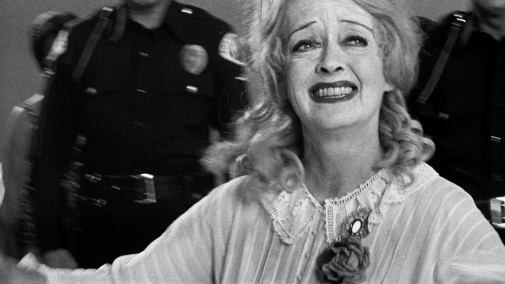
What Ever Happened to Baby Jane? is streaming on HBO Max. You can also rent it on other major platforms.
